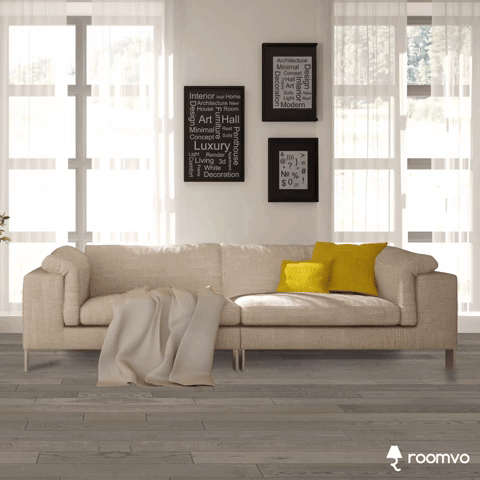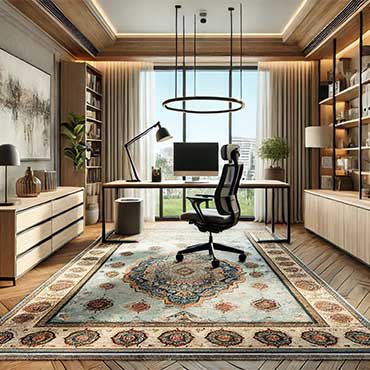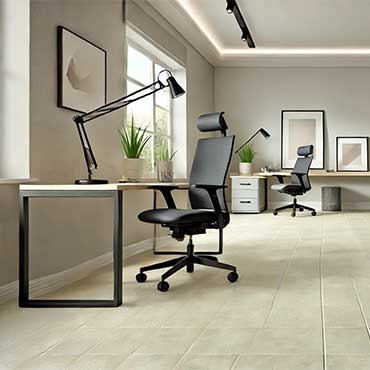
Designers in the Home Office: Enhancing Style and Functionality
Introduction: The Role of Flooring in a Home Office
The home office is a space where functionality meets personal style, demanding a harmonious balance of practicality and aesthetics. Flooring plays a pivotal role in achieving this balance, as it sets the foundation for the room's design, comfort, and usability. Carpeting, known for its warmth, softness, and versatility, offers a compelling choice for home office flooring. But is it the right fit for every design scenario? Let's explore how carpeting influences the aesthetics, ambiance, and functionality of a home office, addressing the needs of interior designers and decorators who seek to create inspiring workspaces for their clients.
The Pros and Cons of Carpeting in the Home Office
Pros
- Comfort: Carpeting provides a plush, cushioned surface that is comfortable underfoot, ideal for long hours at a desk.
- Acoustics: It absorbs sound, reducing noise levels and creating a quieter workspace conducive to focus.
- Aesthetic Versatility: Available in various textures, colors, and patterns, carpeting offers limitless design possibilities to match any decor style.
- Warmth: Carpeting adds a layer of insulation, making the room feel cozy and inviting.
- Safety: Its soft surface minimizes the risk of slips and injuries, especially in a family-friendly home.
Cons
- Maintenance: Carpeting requires regular vacuuming and occasional deep cleaning to maintain its appearance.
- Durability: It may wear down in high-traffic areas or under heavy furniture without proper care.
- Moisture Sensitivity: Carpeting can be susceptible to mold and stains in areas prone to spills or dampness.
- Allergen Accumulation: Dust, pet dander, and allergens can accumulate in carpets, requiring high-efficiency vacuums for sensitive clients.
9 Considerations for Using Carpeting in the Home Office
1. Room Purpose
The primary function of a home office is to provide a productive workspace. Carpeting contributes to this by creating a quiet, focused environment and offering comfort underfoot during extended work hours. Its sound-absorbing qualities are particularly beneficial in reducing distractions, making it a practical choice for remote professionals or creative thinkers.
2. Design Style
Carpeting adapts effortlessly to various design styles, from modern minimalism to traditional elegance. Designers can select from a wide array of textures and patterns, such as plush velvets for luxurious spaces or subtle geometric designs for contemporary offices. A neutral carpet can serve as a calming backdrop, while bold patterns create visual interest.
3. Durability
For a high-traffic home office, durable carpets made from nylon or wool blends offer resilience and longevity. Low-pile options resist wear and indentation from office chairs and furniture, ensuring the space maintains its polished appearance over time.
4. Moisture Exposure
While carpeting is less suited for rooms with high moisture levels, modern treatments like stain-resistant finishes and waterproof backings make it a viable option for home offices, provided spills and humidity are managed.
5. Budget
Carpeting offers flexibility in pricing, accommodating a wide range of budgets. Designers can choose from cost-effective synthetic materials for tighter budgets or invest in premium wool carpets for high-end projects, ensuring accessibility without sacrificing quality.
6. Subfloor Condition
Before installing carpeting, subfloor preparation is essential. A smooth, level subfloor ensures the carpet lays evenly and extends its lifespan. Proper underlayment can also enhance comfort and insulation.
7. Eco-Friendliness
Sustainability-conscious designers can explore eco-friendly carpeting made from natural fibers like wool or recycled materials. These options align with environmentally responsible practices and appeal to clients prioritizing green living.
8. Soundproofing/Insulation
Carpeting excels in soundproofing and thermal insulation. It minimizes ambient noise, such as footsteps or chair movement, and retains heat, creating a comfortable and quiet atmosphere ideal for focused work.
9. Health Considerations
For clients with allergies, hypoallergenic carpeting options can reduce the accumulation of dust and allergens. Regular maintenance with high-efficiency vacuums ensures a clean and healthy workspace.
Impact of Carpeting on Design Elements
Color Scheme and Visual Appeal
Carpeting can harmonize with the room’s color palette, either blending subtly or serving as a bold accent. Light-colored carpets create an open, airy feel, while darker shades add depth and richness.
Style and Theme Coherence
The choice of carpeting can reinforce the room’s overall theme, from sleek, minimalist designs to ornate traditional motifs, ensuring consistency in design language.
Texture and Feel
The tactile quality of carpeting adds a sense of warmth and luxury, enhancing the sensory experience of the room and inviting users to spend more time there.
Room Size Perception
Light or monochromatic carpets can make small offices feel larger, while patterned carpets add character to spacious rooms without overwhelming the design.
Comfort and Usability
The softness of carpeting enhances ergonomic comfort, particularly in areas where users might stand or sit for extended periods.
Acoustic Impact
By dampening sound, carpeting fosters a serene environment, particularly important in open-plan homes or shared spaces.
Pattern and Focal Points
Carpeting with subtle patterns can add depth and interest without overshadowing other design elements, creating a cohesive visual hierarchy in the room.
Conclusion
Carpeting offers a unique blend of practicality and aesthetic appeal for home offices, catering to the needs of interior designers and decorators. Its ability to combine comfort, soundproofing, and visual versatility makes it a strong contender for creating productive yet stylish workspaces. However, considerations like maintenance, durability, and health implications should be weighed to ensure it aligns with the client’s specific needs.
Ultimately, the choice of carpeting in a home office is about creating harmony between function and design. When selected thoughtfully, carpeting has the potential to elevate the ambiance, enhance productivity, and provide a welcoming environment that inspires creativity and focus. For designers seeking to balance elegance with usability, carpeting remains a timeless and transformative flooring option.
Choose Flooring Product : Area Rugs Ideas (4) : Carpeting Ideas (7) : Ceramic/Porcelain Ideas (7) : LVT/LVP Ideas (6)

roomvo
Visualize Flooring In Your Home Office!
Roomvo makes picking new floors easy. Take advantage of our room visualizer tool to see what your home will look like with any flooring products from our catalog. Just upload your photo to see your room come to life.
 Blog
BlogHome Office - Area Rugs
Enhance Your Home Office with Stylish and Functional Area Rugs
This blog post explores the transformative potential of area rugs in creating stylish and functional home offices. Designed for interior designers and decorators, the article delves into how area rugs enhance the home office's aesthetic and practical aspects. By addressing key considerations such as design style, durability, acoustic impact, and eco-friendliness, the blog offers comprehensive guidance on choosing the right home offices to meet both the room's functional needs and the client’s design preferences. It also examines how area rugs can define spaces, add warmth, and improve the overall ambiance while offering solutions for challenges like maintenance and allergen retention.
With Arabella Whitethorn’s expertise in combining fine arts and interior design, the post is infused with professional insights, creative ideas, and practical advice. Readers will gain inspiration from the highlighted benefits and design strategies, making it easier to envision and implement area rugs in their projects. The article concludes by emphasizing the adaptability and visual impact of area rugs, positioning them as a versatile and stylish solution for modern home offices.
Learn More Blog
BlogHome Office - Ceramic Tile
Ceramic Tile in the Home Office: Stylish and Functional Flooring
Ceramic tile is a versatile and durable flooring option that can significantly enhance the design and functionality of a home office. This blog post, authored by Arabella Whitethorn, delves into the key considerations for interior designers and decorators when selecting eco-friendly for this unique space. From its ability to align with various design styles to its hypoallergenic and eco-friendly properties, ceramic tile offers a host of benefits for creating a productive and aesthetically pleasing environment. The article explores how this material balances practicality and elegance, meeting the high standards of both functionality and visual appeal required in a home office.
The post also addresses potential challenges, such as its eco-friendly and acoustic properties, and provides solutions like adding area rugs and soundproofing elements. By examining factors such as budget, subfloor condition, and moisture resistance, the article equips design professionals with a comprehensive understanding of ceramic tile's capabilities. Whether crafting a modern minimalist workspace or a cozy traditional office, designers will find valuable insights on how to leverage ceramic tile to achieve their creative and functional goals.
Learn More Blog
BlogHome Office - Hardwood Flooring
Engineered Hardwood Flooring: The Ideal Choice for Home Offices
This blog post explores the suitability of engineered hardwood flooring for home offices, focusing on how this versatile and durable material meets the needs of both interior designers and decorators. combines the timeless beauty of traditional wood with modern functionality, offering superior resistance to wear, moisture, and temperature changes. The article delves into nine key considerations for selecting flooring in a home office, including design style, durability, soundproofing, and eco-friendliness, providing designers with a comprehensive guide to making informed decisions.
By examining how engineered hardwood impacts aesthetics, comfort, and usability, the post highlights its ability to elevate the ambiance and functionality of a workspace. From its adaptability to different subfloors to its wide range of finishes and textures, this flooring option proves ideal for creating sophisticated, practical home offices. The article concludes with insights into how engineered hardwood contributes to a cohesive design narrative, inspiring professionals to use it as the foundation for their next home office project.
Learn More






